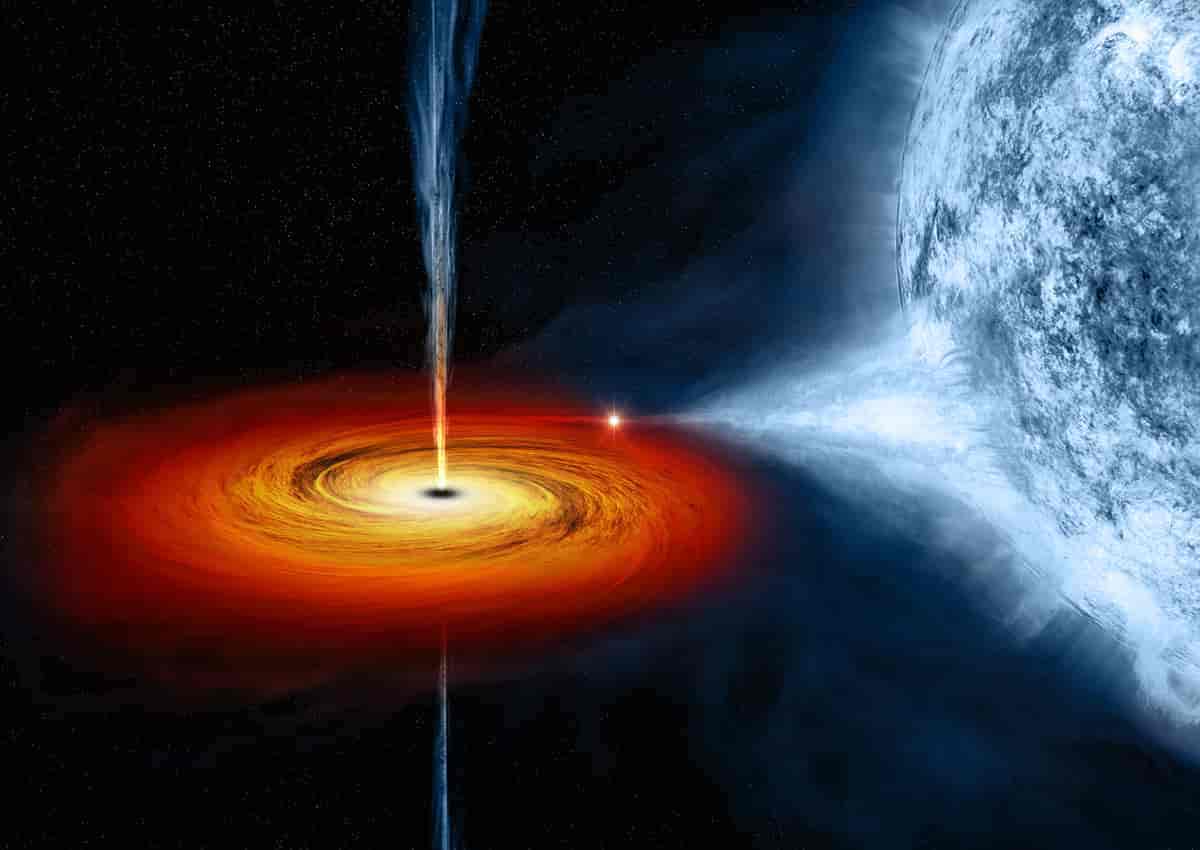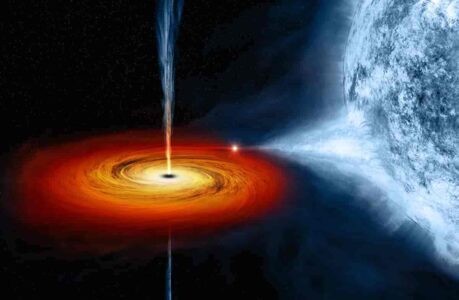Black holes are one of the most fascinating and mysterious objects in the universe. These enigmatic entities are incredibly dense regions of space where the gravitational force is so strong that nothing, not even light, can escape. They are created when massive stars die and collapse under their own weight, creating a singularity that distorts space and time around it.
Despite the fact that black holes have been theorised for centuries, it wasn’t until the 20th century that they were first observed. Today, astronomers use a variety of techniques to study them, including observing their effects on nearby stars and gas clouds, detecting the radiation emitted by their accretion disks, and even detecting the gravitational waves they produce when they merge.
But despite our growing understanding of black holes, there is still much we don’t know about them. For one thing, the interior of a black hole is completely hidden from the outside world, so we can only speculate about what goes on inside. And while we know that black holes can grow to be billions of times more massive than our sun, we don’t know how they get that big.
One thing we do know is that black holes are critical to the structure of the universe. They play a vital role in the formation of galaxies, and their gravity can influence the motion of stars and planets. They are also the ultimate test of our understanding of the laws of physics, as they push the limits of what we know about the nature of space, time, and matter.
So while black holes may be one of the most mysterious and awe-inspiring objects in the universe, they are also one of the most important for us to understand if we want to unlock the secrets of the cosmos.
How are black holes formed
Black holes are formed from the remnants of massive stars that have reached the end of their lives. When a massive star exhausts its nuclear fuel, it can no longer produce the heat and energy needed to counteract the force of gravity, causing it to collapse under its own weight.
As the star collapses, its outer layers are blasted into space in a violent explosion known as a supernova. The remaining core of the star, which can be several times more massive than our sun, becomes so dense that its gravity becomes incredibly strong. This causes the core to collapse further, until it becomes a singularity – a point of infinite density and zero volume.
The singularity is surrounded by an event horizon, a boundary beyond which the gravitational pull of the black hole is so strong that nothing can escape, not even light. This is why black holes appear “black” – they do not emit any light themselves, and anything that comes too close is pulled in and disappears from view.
There are also supermassive black holes, which can be billions of times more massive than our sun, that are believed to be at the centre of most galaxies, including our own Milky Way. The formation of these black holes is not fully understood, but they may have grown from smaller black holes merging together or from the collapse of enormous clouds of gas and dust.
In summary, black holes are formed from the remnants of massive stars that have collapsed under their own gravity, creating a singularity surrounded by an event horizon that traps anything that comes too close. Supermassive black holes may have grown from smaller black holes merging together or from the collapse of enormous clouds of gas and dust.
Who developed the concept of a black hole
The concept of a black hole was first developed in the 18th century by the British geologist John Michell and the French mathematician and astronomer Pierre-Simon Laplace. Michell and Laplace independently speculated that there could be an object in space whose gravity was so strong that nothing, not even light, could escape from it.
However, it wasn’t until the early 20th century that the idea of a black hole was fully developed as a scientific concept. In 1915, Albert Einstein published his theory of general relativity, which provided a new understanding of the nature of gravity and how it affects the structure of space and time. In 1916, German astronomer Karl Schwarzschild used Einstein’s equations to show that a massive object could become so dense that its gravity would create an event horizon – a boundary beyond which nothing could escape.
The term “black hole” was coined in 1967 by American physicist John Wheeler, who used the term to describe these incredibly dense objects whose gravity was so strong that it bent and twisted the fabric of space and time around them.
Since then, the study of black holes has become a major area of research in astrophysics, with astronomers using a variety of techniques to observe and understand their behaviour and effects on the surrounding space.
What is the event horizon
The event horizon is the boundary surrounding a black hole beyond which nothing can escape, not even light. It is the point of no return for any object that gets too close to a black hole. Once an object crosses the event horizon, it is impossible for it to escape the gravitational pull of the black hole, and it will be inevitably drawn towards the singularity at the centre.
The event horizon is determined by the mass of the black hole. The more massive the black hole, the larger its event horizon. For example, a black hole with the mass of our sun would have an event horizon about 3 kilometres in radius, while a supermassive black hole with billions of solar masses would have an event horizon that can be several light-years across.
The event horizon is not a physical object, but rather a theoretical boundary beyond which the gravitational force of the black hole becomes so strong that nothing can escape. It is also important to note that the event horizon is not a static boundary, but can be influenced by factors such as the rotation of the black hole and the presence of matter and energy surrounding it.
The event horizon plays a crucial role in defining the properties and behaviour of black holes. It is also one of the defining features of black holes that makes them such fascinating and mysterious objects in the universe.
Are black holes related to wormholes?
Black holes and wormholes are both theoretical concepts in astrophysics that are related to the curvature of spacetime. However, they are very different phenomena, and while some theories propose a connection between the two, there is no direct evidence of it.
A black hole is a region of space where the gravitational force is so strong that nothing, not even light, can escape it. It is created by the collapse of a massive star or the collision of multiple stars or galaxies. The black hole is characterised by its event horizon, which is a boundary beyond which nothing can escape the gravitational pull of the black hole.
A wormhole, on the other hand, is a hypothetical tunnel that connects two distant points in spacetime, potentially allowing for faster-than-light travel. A wormhole is created by the bending of spacetime, which brings two distant points close together, allowing an object to pass through a shortcut.
While both black holes and wormholes involve the curvature of spacetime, the two phenomena are fundamentally different. A black hole is a region of space that traps anything that enters it, while a wormhole is a hypothetical tunnel that connects two distant points in spacetime.
Some theories propose that it may be possible to create a wormhole using a black hole, by sending a stream of negative energy through it. However, this is purely theoretical and has not been demonstrated experimentally. Therefore, while there may be a connection between black holes and wormholes in theory, there is no concrete evidence of it at this time.
Are there black holes at the centre of galaxies?
Yes, it is believed that most galaxies, including our own Milky Way, have a supermassive black hole at their centre. Supermassive black holes are black holes with masses that are millions or even billions of times that of the Sun. They are thought to form through a process of accretion, where they grow by consuming matter in their vicinity such as stars, gas, and dust.
The presence of a supermassive black hole at the centre of a galaxy is inferred from the behaviour of stars and gas in its vicinity. The gravity of the black hole is so strong that it affects the motion of the surrounding material, causing it to orbit around the black hole. By studying the motion of these objects, astronomers can infer the mass and position of the black hole.
For example, in the case of our own galaxy, the Milky Way, the supermassive black hole is located in the direction of the constellation Sagittarius, about 26,000 light-years from Earth. The black hole, known as Sagittarius A*, has a mass of about 4 million times that of the Sun.
Supermassive black holes play a crucial role in the evolution of galaxies. They are thought to be responsible for regulating the growth of galaxies by heating and ejecting gas, and they can also play a role in the formation of new stars by triggering bursts of star formation. Understanding the properties and behaviour of supermassive black holes is therefore an important area of research in astrophysics.
What would happen if you fell into a black hole?
If you fell into a black hole, you would be torn apart by the strong tidal forces created by the black hole’s gravity. As you approach the black hole, the gravity at your feet would be stronger than the gravity at your head, causing you to be stretched out into a long, thin strand of matter, a process known as spaghettification. Eventually, you would be completely torn apart and crushed into a singularity at the centre of the black hole.
Once you have crossed the event horizon of a black hole, there is no turning back. The gravity of the black hole is so strong that nothing, not even light, can escape. The only thing that can happen is that you continue to be pulled towards the centre, becoming more and more stretched out until you are completely destroyed.
The process of falling into a black hole is not visible from the outside, since nothing can escape the black hole’s gravity. Therefore, no one would be able to witness the event. However, the gravitational effects of the black hole on its surroundings can be observed, such as the bending of light around the black hole, and the heating and emission of radiation from the accretion disk of matter that surrounds it.
In summary, falling into a black hole would be a fatal and highly destructive experience, as the strong tidal forces would tear you apart and crush you into a singularity at the centre.

